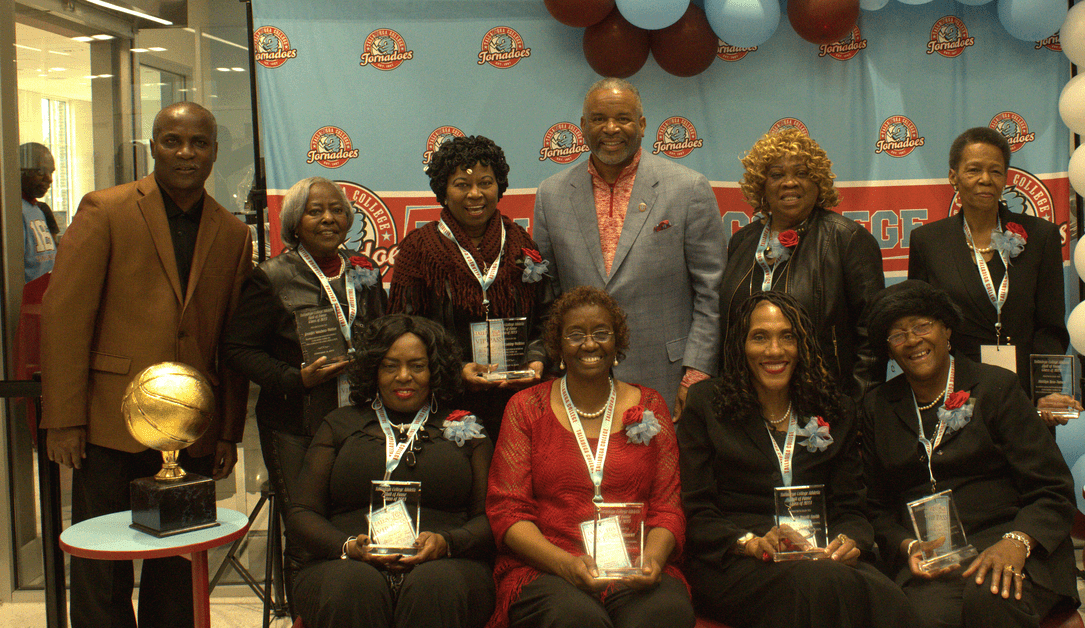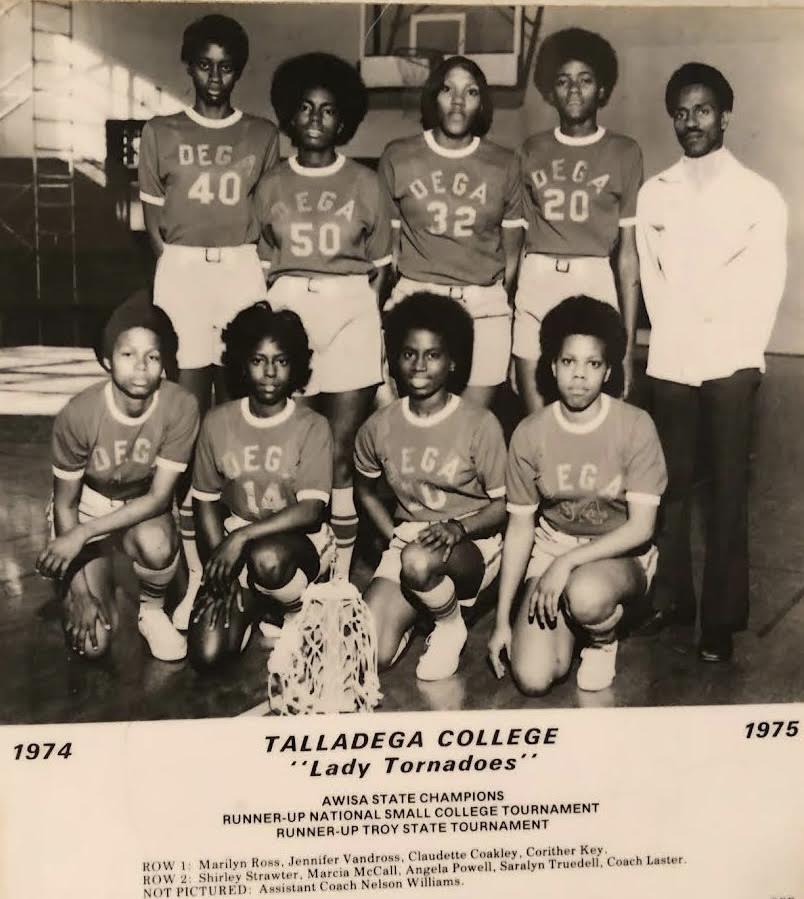Lady Tornadoes Basketball Team Goes from "Talladega Who?" to Alabama State Champion in Two Years
March 31, 2023
Back Row (L-R): Vice President and Athletic Director, Micheal Grant; Jennifer Vandross Walton; Claudette Coakley; President Gregory J. Vincent; Corither Key; Marilyn Ross Turner
Front Row (L-R): Marcia McCall; Shirley Strawter; Angela Powell Smith; Saralyn Truedell
It was a dream come true for the Talladega College Lady Tornadoes team of 1974-1975 when they
were honored as the first class of inductees into the Athletic Hall of Fame on Saturday, February 4,
2023. Almost forty-eight years ago, the Lady Tornadoes were celebrating historic wins and an
unstoppable season.
As they lined up behind the stands in the Student Activity Center, preparing to walk out on the
court and receive their Hall of Fame trophies, family, friends, classmates, and a host of Talladegans
yelled their names and cheered in anticipation. Hearing the crowd roar excitedly, Angela Powell
(Smith) said, “It’s been a long time since we heard that.” “Goosebumps,” Sheryl Strawter said,
rubbing her arm. “What an honor!” said another.
They were reminded of their days as students when school spirit and pride was at its highest after
they played a basketball game in Callahan Gymnasium or returned to campus after a tournament
win.
In the Beginning
When Jennifer Vandross (Walton) came to Talladega College as a freshman in 1971 from
Charleston, South Carolina, there was no women’s basketball team. Vandross had never even played
basketball except during her physical education classes at Talladega. There, she discovered how
much she enjoyed the game.
In 1973, during her junior year, Talladega hired Tiny Laster to teach in the physical education
department and lead a women’s basketball team. Laster, now regarded as a pioneer in women’s
athletics, had previously been the women’s basketball coach at his alma mater, Tuskegee University.
At Talladega, he found that getting a team started was a challenge. According to reports of the time,
Coach Laster resorted to using his charm or outright begging to get money for uniforms and travel
expenses. Despite having a relatively young and inexperienced roster, the newly formed Lady
Tornadoes team worked tirelessly to master their craft and learn to trust in one another on the court.
Vandross remembers that as a coach, “Laster inspired us. He tried to teach us what a team and what
a family should be like.” The closer you are to your teammates, he told them, the better your game
will be on the floor. “You should know your teammate so well, you already know what they’re going
to do with the ball,” Vandross added.
Things, however, did not go well during the first season. Of the fourteen games they played, the
Lady Tornadoes only won two. “We were always getting beat bad,” Vandross remembers. “We were
laughed at when we got to other schools.”
Undeterred, Coach Laster prepared for the new season by aggressively recruiting additional woman
players from various high schools in the South. One of those recruits was Angela Powell (Smith) of
Atlanta, Georgia.
Powell said she was forced to play basketball in high school because of her height. She was almost
six feet tall. She mastered the game by going to her local park every day, watching the guys running
court. Sometimes, she played with them. When Coach Laster came to her high school and recruited
her to play for Talladega, Powell said, “I felt like he was interested in me as a person, not just as an
athlete.”
Coach Laster recruited five other young women from Georgia that year: Saralyn Truedell, Corither
Key, Marilyn Ross (Turner), Marsha McCall, and Shirley Strawter. Claudette Coakley (Watkins) was
recruited from Charleston, South Carolina.
Not only had all of the new recruits played basketball in high school, they had also been honor
students. Marilyn Ross was a salutatorian. Coach Laster knew that in order to get good basketball
talent, he also had to recruit outstanding students.
According to Vandross, this new group of freshmen intimidated the other players on the team. They
were experienced players, some of whom had won high school basketball championships. Jealous,
the other players quit. Vandross, by then a senior, thought about quitting but stayed. She loved the
game. “Coach Laster wanted more from us because he recruited girls who had actually played
basketball before,” Vandross said, “and I was happy to be playing with people who knew the game.”
Before the official start of the 1974-1975 season, the new team of Lady Tornadoes practiced at the
West Lake Recreation Center near Crawford Hall. They played against men who were also there
practicing, and they won. By the time school started, they already had a fan base.
“You’d be surprised at how easy girls are to coach,” Laster noted in a 1975 interview with The
Anniston Star. “They catch on to technique much quicker than males.” But getting used to Coach
Laster’s way of doing things was a challenge for this team. Described as a strict disciplinarian, Coach
Laster required the Lady Tornadoes to get up at six in the morning and run a mile every day. He
believed conditioning was important.
He also confessed to being a “very volatile and emotional” coach. Laster told a reporter at the time,
“I holler, fuss, and occasionally I cuss. I guess you could say I’m demanding but this is the way it has
to be. I’m a perfectionist, yet I stress intensity.”
Under Coach Laster’s leadership, the Lady Tornadoes became known for their fast breaks and close,
inside shots. Laster also believed the more away games they played, the better prepared they would
be to play in big gyms with big crowds.
Inside or outside of the gym, Coach Laster also made sure the Lady Tornadoes presented
themselves as ladies. On Wednesdays, they were required to wear dresses and stockings. “You’re not
going to just show up any kind of way,” they remembered him saying. Presentation was not only
important for them and their self-confidence, it was also important for others to see. Powell recalls
the two-piece baby blue suits they wore with red turtlenecks when they showed up to a game. “We
even had matching basketball bags,” she said.
“Boston in Petticoats”
One of their biggest competitors was Auburn University. According to Powell, Auburn hated them
and took every opportunity during a game to let them know that. The Lady Tornadoes believed they
were subject to “a series of bad calls and rough play.” Saralyn Truedell told a reporter, “I got four
fouls in the first two minutes. I fouled out in the first half.” Strawter added that in one game so
many fouls were called against them that they were down to only three players. “We knew they were
cheating, but we learned to maneuver against them,” Strawter said.
As a team, they changed how they played basketball and came up with plays that would keep them
from getting fouled. They learned to jump higher and block shots from further away. “They couldn’t
stop us,” Powell said.
They were so unstoppable, Coach Laster nicknamed them “Boston in Petticoats.” Powell explained
that at the time, the Boston Celtics was one of the strongest teams out there and Laster believed his
team was just as strong, hence the nickname. Opposing teams sometimes booed them when they
walked into the arena, but soon realized they were up against a powerhouse.
The Lady Tornadoes were defeated by Auburn 54-69. Despite this loss, they were having a good
season. They had gone from a 2-14 win-loss record in their first season to a 20-5 record in their
second season.
They won the Alabama State Championship that year, making them the number-one-ranked team in
the state. They were the Alabama Women’s Intercollegiate Sports Association (AWISA) champions,
and placed second in the Women’s National Invitational Small College Tournament held in Pueblo,
Colorado March 16-18, 1975.
The Lady Tornadoes were so impressive that then-Governor George Wallace sent a telegram to
Coach Laster offering best wishes to the team before their 34-hour, 1,300-mile drive to Colorado.
“When we got out there, everybody was wondering what an all-black school from Talladega,
Alabama was doing there,” Laster told Anniston Star sports writer Charles Hollis. Talladega was the
only HBCU out of twelve teams playing. “Talladega who?” was a popular refrain. It didn’t take long
for the Lady Tornadoes to let everyone know who they were.
The Lady Tornadoes played their first game of the tournament against Southern Utah, winning 82-
49. In that game, they set a new national team record with 82 rebounds. Freshman player, Shirley
Strawter, made 29 of those rebounds, setting an individual rebound record.
The Lady Tornadoes may have placed second in the Women’s National Invitational Small College
Tournament held in Colorado but they remember receiving an even bigger applause than the team
that won the tournament. They had quickly become a crowd favorite, and were gaining a reputation
as one of the best women’s basketball teams in the country.
The 1975-1976 season was equally impressive. They had a 21-5 win-loss record. They won the
Alabama Association for Intercollegiate Athletics for Women (AAIAW) state championship, and
were co-champions in the West Georgia Tournament. At the Region III Large College Tournament
held in Cleveland, Mississippi, they came away with a fourth-place win; but to many, this was one of
the toughest tournaments in the nation and no other Alabama team had ever finished in the top
four. On average, the Lady Tornadoes were scoring 96 points per game. Their 1,185 rebound-record
was the best in the state. They made about 90 shots per game, averaged 343 assists, blocked 171
shots, and stole the ball 432 times.
One of their most notable games during the season was a championship game against Auburn on
December 2, 1975. Auburn had been the defending champion for two years and was one of the
favored teams. In fact, everyone was so sure they were going to win, the trophy had been made in
Auburn’s colors and already had the university’s name engraved on it. In the last three minutes of
the game, though, the Lady Tornadoes overcame a five-point deficit and won the game by nine
points. Powell remembers that they were given the championship trophy as it was, with blue and
orange and Auburn’s name. In true celebratory fashion, the Lady Tornadoes cut a piece of the net to
honor their win. “Auburn sent us a bill for that!” Powell said laughing.
The 1974-1975 Lady Tornadoes Alabama State Championship team should be celebrated for their
grit, determination, and perseverance. Their achievements were a symbol of hope for the future of
women’s basketball at Talladega. They set a new standard for what was possible, and became true
role models for future generations of Lady Tornadoes.
As they waited to be inducted into the Athletic Hall of Fame, the Lady Tornadoes fondly
remembered Coach Tiny Laster who died in 2007. Angela Powell reflected on the team’s journey,
"We were not just a basketball team; we were a family,” she said. “We worked hard, we believed in
each other, and we achieved great things together."

